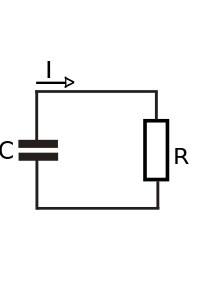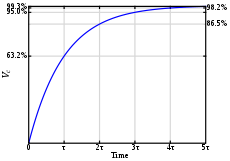| This article needs additional citations for verification. Please help improve this article by adding citations to reliable sources. Unsourced material may be challenged and removed. Find sources: "RC circuit" – news · newspapers · books · scholar · JSTOR (March 2018) (Learn how and when to remove this message) |
| Linear analog electronic filters |
|---|
| Network synthesis filters |
Image impedance filters
|
| Simple filters |
A resistor–capacitor circuit (RC circuit), or RC filter or RC network, is an electric circuit composed of resistors and capacitors. It may be driven by a voltage or current source and these will produce different responses. A first order RC circuit is composed of one resistor and one capacitor and is the simplest type of RC circuit.
RC circuits can be used to filter a signal by blocking certain frequencies and passing others. The two most common RC filters are the high-pass filters and low-pass filters; band-pass filters and band-stop filters usually require RLC filters, though crude ones can be made with RC filters.
Natural response

The simplest RC circuit consists of a resistor and a charged capacitor connected to one another in a single loop, without an external voltage source. Once the circuit is closed, the capacitor begins to discharge its stored energy through the resistor. The voltage across the capacitor, which is time-dependent, can be found by using Kirchhoff's current law. The current through the resistor must be equal in magnitude (but opposite in sign) to the time derivative of the accumulated charge on the capacitor. This results in the linear differential equation
where C is the capacitance of the capacitor.
Solving this equation for V yields the formula for exponential decay:
where V0 is the capacitor voltage at time t = 0.
The time required for the voltage to fall to V0/e is called the RC time constant and is given by,
In this formula, τ is measured in seconds, R in ohms and C in farads.
Complex impedance
The complex impedance, ZC (in ohms) of a capacitor with capacitance C (in farads) is
The complex frequency s is, in general, a complex number,
where
- j represents the imaginary unit: j = −1,
- σ is the exponential decay constant (in nepers per second), and
- ω is the sinusoidal angular frequency (in radians per second).
Sinusoidal steady state
Sinusoidal steady state is a special case in which the input voltage consists of a pure sinusoid (with no exponential decay). As a result, and the impedance becomes
Series circuit

By viewing the circuit as a voltage divider, the voltage across the capacitor is:
and the voltage across the resistor is:
Transfer functions
The transfer function from the input voltage to the voltage across the capacitor is
Similarly, the transfer function from the input to the voltage across the resistor is
Poles and zeros
Both transfer functions have a single pole located at
In addition, the transfer function for the voltage across the resistor has a zero located at the origin.
Gain and phase

The magnitude of the gains across the two components are
and
and the phase angles are
and
These expressions together may be substituted into the usual expression for the phasor representing the output:
Current
The current in the circuit is the same everywhere since the circuit is in series:
Impulse response

The impulse response for each voltage is the inverse Laplace transform of the corresponding transfer function. It represents the response of the circuit to an input voltage consisting of an impulse or Dirac delta function.
The impulse response for the capacitor voltage is
where u(t) is the Heaviside step function and τ = RC is the time constant.
Similarly, the impulse response for the resistor voltage is
where δ(t) is the Dirac delta function
Frequency-domain considerations
These are frequency domain expressions. Analysis of them will show which frequencies the circuits (or filters) pass and reject. This analysis rests on a consideration of what happens to these gains as the frequency becomes very large and very small.
As ω → ∞:
As ω → 0:
This shows that, if the output is taken across the capacitor, high frequencies are attenuated (shorted to ground) and low frequencies are passed. Thus, the circuit behaves as a low-pass filter. If, though, the output is taken across the resistor, high frequencies are passed and low frequencies are attenuated (since the capacitor blocks the signal as its frequency approaches 0). In this configuration, the circuit behaves as a high-pass filter.
The range of frequencies that the filter passes is called its bandwidth. The point at which the filter attenuates the signal to half its unfiltered power is termed its cutoff frequency. This requires that the gain of the circuit be reduced to
- .
Solving the above equation yields
which is the frequency that the filter will attenuate to half its original power.
Clearly, the phases also depend on frequency, although this effect is less interesting generally than the gain variations.
As ω → 0:
As ω → ∞:
So at DC (0 Hz), the capacitor voltage is in phase with the signal voltage while the resistor voltage leads it by 90°. As frequency increases, the capacitor voltage comes to have a 90° lag relative to the signal and the resistor voltage comes to be in-phase with the signal.
Time-domain considerations
- This section relies on knowledge of e, the natural logarithmic constant.
The most straightforward way to derive the time domain behaviour is to use the Laplace transforms of the expressions for VC and VR given above. This effectively transforms jω → s. Assuming a step input (i.e. Vin = 0 before t = 0 and then Vin = V afterwards):


Partial fractions expansions and the inverse Laplace transform yield:
These equations are for calculating the voltage across the capacitor and resistor respectively while the capacitor is charging; for discharging, the equations are vice versa. These equations can be rewritten in terms of charge and current using the relationships C = Q/V and V = IR (see Ohm's law).
Thus, the voltage across the capacitor tends towards V as time passes, while the voltage across the resistor tends towards 0, as shown in the figures. This is in keeping with the intuitive point that the capacitor will be charging from the supply voltage as time passes, and will eventually be fully charged.
These equations show that a series RC circuit has a time constant, usually denoted τ = RC being the time it takes the voltage across the component to either rise (across the capacitor) or fall (across the resistor) to within 1/e of its final value. That is, τ is the time it takes VC to reach V(1 − 1/e) and VR to reach V(1/e).
The rate of change is a fractional 1 − 1/e per τ. Thus, in going from t = Nτ to t = (N + 1)τ, the voltage will have moved about 63.2% of the way from its level at t = Nτ toward its final value. So the capacitor will be charged to about 63.2% after τ, and essentially fully charged (99.3%) after about 5τ. When the voltage source is replaced with a short circuit, with the capacitor fully charged, the voltage across the capacitor drops exponentially with t from V towards 0. The capacitor will be discharged to about 36.8% after τ, and essentially fully discharged (0.7%) after about 5τ. Note that the current, I, in the circuit behaves as the voltage across the resistor does, via Ohm's Law.
These results may also be derived by solving the differential equations describing the circuit:
The first equation is solved by using an integrating factor and the second follows easily; the solutions are exactly the same as those obtained via Laplace transforms.
Integrator
Consider the output across the capacitor at high frequency, i.e.
This means that the capacitor has insufficient time to charge up and so its voltage is very small. Thus the input voltage approximately equals the voltage across the resistor. To see this, consider the expression for given above:
but note that the frequency condition described means that
so
which is just Ohm's Law.
Now,
so
which is an integrator across the capacitor.
Differentiator
Consider the output across the resistor at low frequency i.e.,
This means that the capacitor has time to charge up until its voltage is almost equal to the source's voltage. Considering the expression for I again, when
so
Now,
which is a differentiator across the resistor.
Integration and differentiation can also be achieved by placing resistors and capacitors as appropriate on the input and feedback loop of operational amplifiers (see operational amplifier integrator and operational amplifier differentiator).

Parallel circuit

The parallel RC circuit is generally of less interest than the series circuit. This is largely because the output voltage Vout is equal to the input voltage Vin — as a result, this circuit does not act as a filter on the input signal unless fed by a current source.
With complex impedances:
This shows that the capacitor current is 90° out of phase with the resistor (and source) current. Alternatively, the governing differential equations may be used:
When fed by a current source, the transfer function of a parallel RC circuit is:
Synthesis
It is sometimes required to synthesise an RC circuit from a given rational function in s. For synthesis to be possible in passive elements, the function must be a positive-real function. To synthesise as an RC circuit, all the critical frequencies (poles and zeroes) must be on the negative real axis and alternate between poles and zeroes with an equal number of each. Further, the critical frequency nearest the origin must be a pole, assuming the rational function represents an impedance rather than an admittance.
The synthesis can be achieved with a modification of the Foster synthesis or Cauer synthesis used to synthesise LC circuits. In the case of Cauer synthesis, a ladder network of resistors and capacitors will result.
See also
- RC time constant
- RL circuit
- LC circuit
- RLC circuit
- Electrical network
- List of electronics topics
- Step response
References
- Horowitz & Hill, p. 1.13
- Bakshi & Bakshi, pp. 3-30–3-37
Bibliography
- Bakshi, U.A.; Bakshi, A.V., Circuit Analysis - II, Technical Publications, 2009 ISBN 9788184315974.
- Horowitz, Paul; Hill, Winfield, The Art of Electronics (3rd edition), Cambridge University Press, 2015 ISBN 0521809266.





 and the impedance becomes
and the impedance becomes
















 .
.






 given above:
given above:











